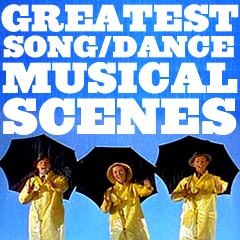
|
Musical Moments and Scenes B - 1 |
| B | ||||||
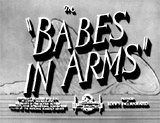
|
Babes in Arms (1939) Busby Berkeley directed this very successful MGM musical loosely based on the 1937 Richard Rodgers and Lorenz Hart stage show. This was the first of the many "Mickey-Judy" musicals (the most successful musical team of the studio) produced by Arthur Freed, with Oscar-nominated Rooney as energetic Mickey Moran and Garland as Patsy Barton in a "let's put on a show" plot. The two rebellious teens sang the Arthur Freed/Nacio Herb Brown song Good Morning (pictured) (with Mickey on the piano) (reprised over a decade later in Singin' in the Rain (1952)), and Garland sang the plaintive I Cried For You (pictured). During the performance of the title tune Babes in Arms (pictured), the pair strode through their town gathering others kids to join them in the street, and the film ended with the patriotic finale God's Country (pictured). |
   
|
||||
  (colorized) |
Babes in Toyland (1934) (aka March of the Wooden Soldiers) MGM's Christmas musical produced by Hal Roach Studios (best known for The Little Rascals short films) in 1934 contained music by Victor Herbert and lyrics by Glen MacDonough. The romantic melodrama, based upon Mother Goose characters, was best known for the theme song Toyland (pictured), played and sung by Mother Goose (Virginia Karns) and the chorus during the opening storybook credits (pictured):
The musical also featured the famed comedy duo Laurel and Hardy (as Stannie Dum and Ollie Dee) (pictured twice) - apprentices for the toymaker in Toyland. In the storybook fable-come-to-life, Stannie and Ollie provided comic relief for the two leads:
The two tried to save her from marrying mean Silas Barnaby (Henry Kleinbach/ Brandon).
|
   
|
||||
Back in the Saddle (1941) "Singing cowboy" Gene Autry's signature western for Republic Pictures in the early 40s took the name of Autry's Back in the Saddle Again tune, penned by Ray Whitley. The theme song, Back in the Saddle (pictured), was originally written by Whitley for RKO Radio's western crime film Border G-Man (1938) starring George O'Brien, and then revived for Autry's own Rovin' Tumbleweeds (1939). Another perennial favorite You Are My Sunshine (pictured) was sung by Autry, as well as Johnny Mercer's I'm an Old Cowhand (pictured) (sung by Gene Autry and Mary Lee). |
  
|
|||||
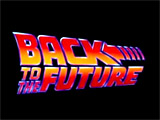
|
Marty McFly (Michael J. Fox), a mid-80s teen stuck in the year 1955, played lead guitar and sang the 1950's rock 'n' roll song Johnny B. Goode (pictured) [originally recorded by Chuck Berry in 1958] at his parents' 1955 "Enchantment Under the Sea" prom night dance, to encourage their romance when the lead musician was put out of commission. But he became carried away during his performance - playing 1980's heavy metal guitar riffs, strumming behind his head, skidding on the floor with his knees and knocking over an amplifier. At the end when he remembered belatedly that he was playing to a 1950's audience, he told the stunned, blankly-staring prom-goers:
|
 
|
||||

|
Ball of Fire (1941) Singer/burlesque dancer 'Sugarpuss' O'Shea (Barbara Stanwyck) made a stunning entrance into a nightclub, singing Drum Boogie (pictured) (performed by Gene Krupa and his jazz band) - in this Howard Hawks-directed screwball comedy. In the audience was stuffy and priggish linquist professor Bertram Potts (Gary Cooper), taking notes on slang words for a project he was leading on writing an encyclopedia. The leggy Sugarpuss was wearing a glittering, sequined outfit with a high-slit up the side. Afterwards, she sat at a table with a black polished table-top next to drummer Krupa, while surrounded by a crowd of spectators. With Krupa, who had exchanged his drum-sticks for a pair of matches, the two performed a more hushed rendition of Drum Boogie (pictured) to the beat of the matchsticks on the side of a matchbox. Later in the film, she taught the seven elderly bachelor professors she was living with how to do the conga dance. She first taught them the proper tempo, and then led them in an energetic dance line. When an amazed Potts entered the room along with shocked housekeeper/cook Miss Bragg (Kathleen Howard), 'Sugarpuss' invited 'Pottsie' to "hook on" to the snaking line, but he refused and turned off the music. |
  
|
||||

|
Band of Outsiders (1964, Fr.) (aka Bande à Part) Jean-Luc Godard's quirky, low-budget and experimental Nouvelle Vague (French New Wave) heist-crime drama was about an awkward love triangle between two young, aspiring low-life Parisian criminals: sad intellectual dreamer Franz (Sami Frey), vulgar and brutish opportunist Arthur (Claude Brasseur), and beautiful naive ingenue Odile Monod (Anna Karina), who attended classes with Franz. The most celebrated musical sequence occurred in the half-empty basement of a Parisian cafe-restaurant. There, the three lead characters performed a playful, impromptu scene. Each of the trio of characters separately line-danced the non-contact 'Madison' to the recorded music on the jukebox (copied in Tarantino's Pulp Fiction (1994)). It was a badly executed, hip-swaying dance routine with jumps, turns, finger-snaps and hand-claps. During the sequence, the music was partly cut off (reinforcing the sound of their shoe-tappings on the floor), and the Narrator's (Godard himself) voice-over told us what each of the participants was thinking or feeling:
|
 
|
||||

|
This Vincente Minnelli-directed MGM film, with a witty screenplay by Betty Comden and Adolph Green, has often been thought of as Fred Astaire's best MGM musical, although it did poorly at the box-office, and had three Oscar nominations: Best Score (Adolph Deutsch), Best Original Screenplay, and Best Costume (Color) Design. Five songs were also reprised from the original 1931 Broadway musical called The Band Wagon (which also starred Astaire), created by the song-writing team of Howard Dietz and Arthur Schwartz. Many remember the film's anthem song That's Entertainment (pictured) - a celebration of show-business that was sung and danced by the ensemble (Jack Buchanan, Oscar Levant, Nanette Fabray, and Fred Astaire), and reprised at the end of the film (also pictured).
In the plot, Tony Hunter (Fred Astaire), a fading Hollywood movie star and a song-and-dance man (known for his top-hat, cane and tails acts and as "the grand old man of the dance") was interested in a Broadway comeback in NYC. Tony performed the solo song By Myself (pictured) as he strolled down a railroad platform after reporters instead favored the arrival of Ava Gardner (as Herself), and the duet A Shine On Your Shoes (pictured) with a black shoeshine boy (Leroy Daniels) in a 42nd Street penny arcade. He was chosen to perform in a new light-hearted stage musical (known as 'The Band Wagon') scripted by his friends Lily Marton (Nanette Fabray) and Lester Marton (Oscar Levant), a show-writing couple who would also perform in their play. The Martons promoted acclaimed actor-director Jeffery Cordova (Jack Buchanan) to be the director of 'The Band Wagon', although he had never directed a musical comedy. Hunter was paired with Broadway novice and rising, long-legged, classically-trained ballerina Gabrielle "Gaby" Gerard (Cyd Charisse) as his co-star; to convince her to join the show, Cordova offered Gaby's mentor and boyfriend Paul Byrd (James Mitchell) the position of choreographer. To test their dancing compatibility, the duo of white-suited Hunter and white-dressed ballerina Gabrielle went for a carriage ride in Central Park, and then performed the sublime, classic, graceful, and elegant 'getting to know you' love duet and production number Dancing in the Dark. (pictured) Although the premiere of Cordova's modified show failed miserably in its debut in New Haven, Connecticut, it eventually succeeded when it was revamped, rewritten and returned to the Martons' original script and songs; the show became a huge success as it traveled to Philadelphia, Boston, Washington, D.C., and Baltimore, before returning to Broadway. Another of the film's numbers was an elegant soft-shoe dance of tuxedoed, top-hatted Tony and producer-director Jeffrey Cordova to the tune: I Guess I'll Have to Change My Plan. (pictured) In addition, in the hilarious Triplets (pictured) - Astaire, Nanette Fabray, and Jack Buchanan were dressed up as baby siblings and performed on their knees. In the film's dance finale, Tony and Gabrielle appeared in the film's jazzy balletic 8-minute dreamy, pulp B-movie production number: the Girl-Hunt ballet (memorably choreographed by Michael Kidd) (pictured) - it was a film-noirish take-off or satire of Mickey Spillane's hard-boiled pulp detective novels; in the number, Hunter and "Gaby" portrayed the characters of private eye Rod Riley and two dangerous, sinister femme fatales - a blonde and a brunette siren in a slinky, sparkling red dress: ("She came at me in sections...more curves than the scenic railway....She was bad! She was dangerous. I wouldn't trust her any farther than I could throw her. But, she was my kind of woman"). The show was an immediate hit, and Gabrielle (who had broken up with Paul) confessed her love for Tony, and praised him for managing and saving the show: "We've come to love you, Tony. We belong together. The show's going to run a long time. As far as I'm concerned, it's going to run forever.'' |
 "By Myself"  "A Shine On Your Shoes"   "Dancing in the Dark"  "I Guess I'll Have to Change My Plan"  "Triplets"   "The Girl Hunt Ballet"  Praise for Tony by the Cast and "Gaby" as the Film Ended |
||||
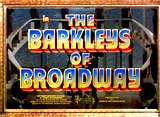
|
The Barkleys of Broadway (1949) This celebrated MGM film featured the legendary last performance that reunited RKO's dancing pair of Ginger Rogers and Fred Astaire after a ten-year gap - it was their first and only film in Technicolor. They performed The Swing Trot (under the credits) (pictured). They also executed the Scottish-flavored song/dance My One and Only Highland Fling (pictured), and tap-danced in rehearsal clothes to the lively and light-hearted Bouncin' the Blues (pictured). To Rogers, Astaire sang You'd Be Hard to Replace (pictured), and he also sang and they danced together for They Can't Take That Away From Me (pictured) (reprised from Shall We Dance (1937)) as well as the film's brief but extravagant finale number Manhattan Downbeat (pictured). The film was also notable for Oscar Levant's keyboard rendition of The Sabre Dance, and Astaire's solo Shoes With Wings On (pictured) to six disembodied pairs of feet. |
      
|
||||

|
Bathing Beauty (1944) This MGM film was notable for being the first starring big-budget vehicle for Esther Williams (as pretty gym/swimming teacher Caroline Brooks). Williams performed a famous Technicolored water ballet in the five-minute finale, setting the choreographical pattern for future aquacade musicals with:
|
   
|
||||
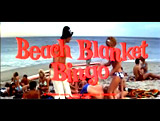
|
Beach Blanket Bingo (1965) The Beach Party series of youth films or teen flicks included Beach Party (1963), Muscle Beach Party (1964), Bikini Beach (1964), Pajama Party (1964), and Beach Blanket Bingo (1965), some of which starred Frankie Avalon and busty All-American ex-Mouseketeer Annette Funicello. These mid-60s films were unique because they added pop music (almost presented as rock videos) to the fantasy 'beach party' theme, and always featured stereotypes such as sexy virginal females and lusty males. However, they were mostly sexless, lightweight, and antiseptic, and served to highlight the well-groomed antics of beachgoers (on a perpetual summer vacation). Beach Blanket Bingo was the classic 'beach party' film, with Frankie Avalon (now 26 years old!, and in his last and major starring role in the 'Beach Party' films) who caused partner Annette Funicello (as Dee Dee) to try sky-diving when he went to rescue kidnapped pop singer Sugar Kane (future Dallas star Linda Evans) from biker Eric Von Zipper's (Harvey Lembeck) gang. Small roles were played by Hollywood icon Buster Keaton (as a lecherous beachcomber) and Beach Boys singer Brian Wilson. |
 
|
||||

|
Beaches (1988)
Gary Marshall's sentimental tearjerker about a lifelong friendship included many memorable songs performed by low-brow Jewish singer Cecilia C.C. Bloom (Bette Midler), including the Grammy-winning Wind Beneath My Wings (pictured) on the soundtrack during a montage sequence. Other songs included the dramatic expressionist, experimental stage song Oh Industry!, and the bawdy vaudeville musical number Otto Titsling (pictured) named after the inventor of the brassiere or 'modern foundation garment':
C.C. also delivered a powerful tribute to her deceased best friend - uptight WASP mother Hillary Whitney Essex (Barbara Hershey), by singing The Glory of Love (pictured) (reprising her earlier performance as an 11 year-old (Mayim Bailik, voice by Melissa Garcia), also pictured), now wearing a wine-velvet gown:
|
   
|
||||
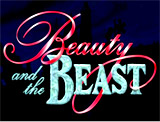
|
Beauty and the Beast (1991)
This film (the only animated film to be nominated for Best Picture) was a retelling of the classic tale by Jeanne-Marie Leprince de Beaumont. From its six nominations, it won two Academy Awards: Best Original Score (by Alan Menken and Howard Ashman) and Best Original Song (the title track). The other four nominations were:
[Note: The film had three competing nominations for Best Original Song - a feat that was repeated by The Lion King (1994), Dreamgirls (2006), and Enchanted (2007). Subsequently, AMPAS rules were changed to limit a film to only two nominations within this category.] Its powerful and memorable tunes included:
|
     
|
||||

|
Bedknobs and Broomsticks (1971) This film (with a combination of live-action and animation) featured many lighthearted songs, including Beautiful Briny Sea (pictured), as charming witch Miss Eglantine Price (Angela Lansbury) took her beau warlock Professor Emelius Browne (David Tomlinson) and her three adopted surly charges, the three Rawlins children, Charlie, Carrie, and Paul, under the sea in a fantasy sequence - riding on an enchanted bed. During the song Substitutiary Locomotion (pictured), Eglantine singlehandedly cast her telekenetic spell twice - the second time to reanimate suits of armor and old military uniforms from a local museum to frighten away an invading Nazi raiding party. |
 
|
||||

|
Beetlejuice (1988) In this haunted comedy, there's the famous Day-O scene in which recently-deceased ghosts Adam and Barbara Maitland (Alec Baldwin and Geena Davis) pulled a 'parlor trick' at the dinner table. The two attempted to spook the yuppie Deetz family at a hosted party by having obnoxious artist-wife Delia (Catherine O'Hara) belt out (lip-synch) the calypso Day-O (The Banana Boat Song) (pictured) - in Harry Belafonte's voice - and by having everyone dance around the table. In the finale scene, morose daughter Lydia Deetz (Winona Ryder) danced in mid-air and lip-synched Jump in the Line (Shake, Shake, Senora) (pictured) with a chorus line of dead football player corpses on the staircase behind her. |
   
|
||||
(alphabetical by film title) Introduction | A-1 | A-2 | B-1 | B-2 | B-3 | C-1 | C-2 | D-1 | D-2 | E | F-1 | F-2 | G-1 | G-2 H-1 | H-2 | I-J | K | L-1 | L-2 | M-1 | M-2 | N-O | P-1 | P-2 | R-1 | R-2 | S-1 | S-2 | S-3 | T | U-V | W | X-Z |